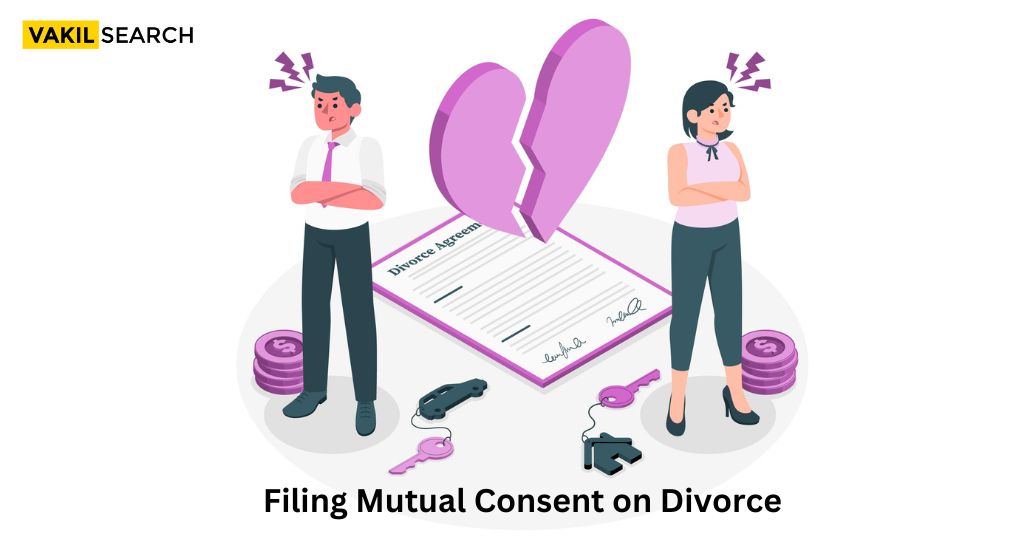Before filing a mutual consent on divorce, one needs to know the importance of the cooling-off period, various considerable factors, and the ways to waive it.
A recent case granting divorce by mutual consent highlighted that you should not read a judgment the same way as a statute or interpret it with rigidity. This positive precedent gives individuals more control over their private marital affairs and decreases state involvement in citizens’ lives. This article highlights what is divorce by mutual consent, what is the cooling period, and how to waive off the cooling period.
What is Mutual Consent in Divorce?
If both parties agree to dissolve their marriage cordially, it is more peaceful than fighting in Court and slandering one another. They may File a petition at a District Court under amendment Section 13B of the Hindu Marriage Act, 1955 so that the court can grant them the divorce decree. The divorce will not be affected by proceedings before the Panchayat. It requires processing through Matrimonial Courts.
What is Cooling-off Period in Mutual Consent on Divorce?
The Hindu Marriage Act, 1955 Section 13-B allows couples to seek divorce by Divorce on mutual consent. Consensual divorce stipulates that both spouses agree to peaceful separation.
It is easy to legally dissolve a marriage by mutual consent. Section 13-B (2), Hindu Marriage Act, 1955, states a six-month cooling period between the first and last motions for divorce to explore the possibility of settlement and cohabitation. This cooling period is also known as the statutory period.
When Can Cooling-Off Period be Waived Off?
You can consider the following questions when you want to consider waiving the cooling period:
- How long did the marriage last?
- How long was the couple apart?
- Possibility of reconciliation
- How long was the couple together?
- How long has the litigation been pending?
- Existence of any other proceedings between the parties
- Whether the couple has a child/ children together
- Whether the parties reached a free settlement regarding maintenance, Alimony, or child custody.
What Conditions Can the Cooling Period be Waived-Off?
The Hon’ble Supreme Court ruled in Amardeep Singh V Harveen Kaur that mutual divorce can be granted if the six months cooling period is waived. Section 13B (1) deals with the Court’s jurisdiction.
Also, it addresses the petition’s sustainability, so the parties can’t repeal it. However, Section 13B (2) is administrative and must not be repealed unless the Court examines all circumstances and details in every situation that might allow for reconciliation. Article 142 is not mandatory. It was useful historically for Courts to not allow time in exceptional circumstances. The Court noted that Amardeep’s case was not mandatory.
If a party wants to waive off the statutory 6 months waiting period as per Section 13B (2), the Court will require the following before they make the final decision:
The six months statutory period described in Section 13B (2) is essential. In addition, the one-year statutory period as per Section 13B (1) of the parties’ separation has already ended before the first motion itself.
All mediation or reconciliation efforts, including Order XXXII A Rule 3 CPC or Section 23 (2) of the Family Courts Act and Section 9 for reuniting the parties have failed. Also, there are no chances of success with any more efforts. The parties can genuinely settle their distinctiveness, including child custody, alimony, or any of such issues between themselves.
The period of waiting can only prolong their agony. Also, after the first petition ends, in the first week, the waiver application submission is possible in these situations. You can do it by applying the reasons for the request for the waiver. The Court can change the control over the second waiver period.
What are the things to think before filing for divorce?
Filing for divorce is a significant decision that involves emotional, financial and legal consequences. Before taking this step, there are crucial factors to contemplate.
- Firstly, think about the impact on any children you might have. Co-parenting and child custody arrangements should be discussed thoughtfully.
- Financial matters are equally important. Consider your financial needs, assets, liabilities and need for spousal support.
- Emotionally, be prepared for the toll it may take on your mental health.
- Seek emotional support from friends or a therapist.
- Familiarize yourself with the divorce laws in your jurisdiction, as they vary by location.
- Explore alternative dispute resolution methods like mediation or counseling to amicably resolve issues.
- Make sure you are emotionally and mentally ready for the divorce process, as it can be a challenging journey.
What documents will you need while filing for divorce?
When filing for a mutual consent divorce in India, certain documents are essential to support your case. These documents include:
- Your marriage certificate, identification proofs, photographs and proof of residence.
- Additionally, you’ll need to provide details of your assets, liabilities and income.
- If you have children, documents related to child custody and maintenance arrangements will be required.
What are the steps involved in getting a mutual consent divorce?
Obtaining a mutual consent divorce in India involves a structured legal process. The first step is to file a joint divorce petition before the appropriate family court. This petition outlines the terms of the divorce, including alimony, child custody, and property division. After this, a 6-month cooling-off period is mandated, during which both parties can reconsider their decision.
Upon completion of the cooling-off period, the court reviews the case to ensure that the divorce terms are agreeable and in the best interest of both parties and any children involved.
If the court is satisfied, it grants the divorce decree. The final step is the issuance of the divorce certificate, which formally ends the marriage.
The Judgments of Different Courts
Case 1:
Consensual divorce requires that both husband and wife agree to divorce, and both seek divorce as a solution. The High Court of Rajasthan considered this question in Suman Vs. Surendra K’s case. This interregnum period is present to allow the partners to think about their steps. One of the partners, or both of them, can have other considerations during the interregnum period. After that, they can decide to end their marriage.
Case 2:
The Delhi High Court Division Bench in Rajiv Chhikara Vs. Sandhya Matu’s case ruled that the act of restraining from mediation constitutes mental cruelty. In this case, the Court observed that the couple had been separated since 2009 and that the relationship they had was irreparable. In these circumstances, the Court ordered that one of the partners maintain the marital bond.
Case 3:
The case of Dinesh and Ranjana Gulati was one in which the husband brought contempt for the procedures against his wife. This was based on a petition he had filed against his wife, claiming that a housewife failed to comply with her spouse’s request.
The Family Court: https://districts.ecourts.gov.in/ launched Suo Motu contempt proceedings in accordance with the spouse for not complying with the consent decree. Also, the Division Bench ruled that an order to start Suo Motu contempt proceedings fails to recognize the mutuality element of Section 13B. Once the parties were not able or unwilling, the only recourse available was to reinstate the authentic divorce petition.
Can Mutual Consent on Divorce Be Withhold?
If one of the parties changes their mind and wants to save their marriage, they can file a petition before the Court. The application states that he/she wishes to withdraw consent for the divorce proceedings as they want a second chance for their marriage. If both spouses agree to the withdrawal, the Court may dismiss the petition.
FAQ’s
What is the legal process for filing a mutual consent divorce?
The legal process for a mutual consent divorce in India involves filing a joint petition before the appropriate family court. Both parties must agree to all divorce terms, including alimony, child custody and property division. After a cooling-off period, the court will review the case and if satisfied, grant the divorce decree.
How much does a mutual consent divorce cost in India?
The cost of a mutual consent divorce may vary but includes court fees, lawyer fees, and other expenses. The exact amount depends on the complexity of the case and legal fees.
What documents are needed for filing a mutual divorce?
Commonly required documents include marriage certificate, identification proofs, photographs, proof of residence and details of assets, liabilities and income.
Can a mutual divorce agreement be challenged in court later?
In most cases, mutual consent divorce agreements are legally binding and can be challenged only on specific grounds such as fraud or coercion.
What's the difference between a contested divorce and a mutual consent divorce?
A contested divorce involves disagreements and legal proceedings, while a mutual consent divorce is based on the mutual agreement of both spouses.
How does property and asset division work in a mutual consent divorce?
In a mutual divorce, spouses decide property and asset division mutually. If they can't agree, the court may intervene and settle the matter.
Can couples reconcile and cancel the divorce proceedings if they change their minds?
Yes, couples can withdraw their mutual consent divorce petition at any time before the final decree is granted.
Are there any counseling or mediation sessions required before a mutual consent divorce is granted?
Some Indian courts may recommend counseling or mediation, especially if there are children involved. Though mediation is not mandatory it can aid in resolving disputes.
How is child custody determined in the case of a mutual consent divorce?
Child custody arrangements are part of the divorce agreement and should be mutually agreed upon by both parents. The court also ensures the child's best interests are protected.
Do both spouses need to hire separate lawyers for mutual consent divorce?
While it's not mandatory, it's advisable for each spouse to have their own lawyer to protect their interests and ensure a fair agreement.
Are there any specific grounds required to file for a mutual consent divorce?
No specific grounds are required for a mutual consent divorce. Both spouses need to agree to end the marriage as it is considered a no-fault divorce process.
Conclusion
Consensual divorce is when the spouses end their marriage on their own. The cooling-off period can positively affect couples by allowing for a fresh perspective. While mutual consent on divorce is the best way to end a marriage, it’s important to consider the future effects. Both spouses must strive to end their marriage respectfully, without causing more trouble or harm than already done.
Read more:-










